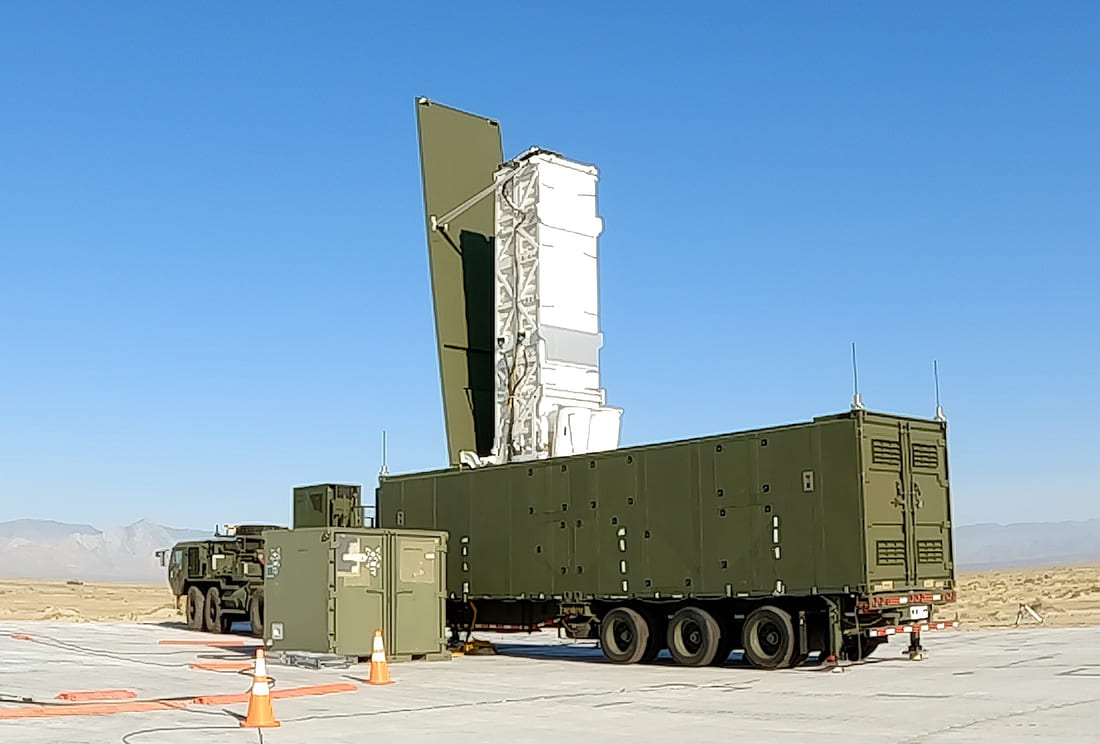Army planners want a launcher they can move and hide faster than Typhon, the Mid-Range Capability battery that fires SM-6 and Tomahawk. Lt. Gen. Joel “JB” Vowell calls the current rig “rather large, long” because it must stand upright before launch, slowing setup and tear-down. Lt. Gen. Robert Rasch, who runs the Rapid Capabilities and Critical Technologies Office, says one option shifts the same mission to the new Common Autonomous Multi-Domain Launcher, or CAML.
Typhon came together quickly to plug the range gap between the Precision Strike Missile and the Long-Range Hypersonic Weapon. Engineers dropped a Navy Mk 41 vertical tube into a 40-foot ISO container and tied it into an Army fire-control rack. The fix works, yet it hogs road space, needs firm ground, and takes time to level. Those limits showed in July when soldiers in Australia fired an SM-6 from Typhon to sink a sea target.
Rasch doesn’t plan to scrap the firepower. CAML’s first build won’t need SM-6, though later blocks might. He calls Typhon “very big” for a force that has to move at speed and hints at a wider roll-up: pack as many cross-domain missiles as possible on one launcher family, trim crews, and keep batteries alive under fire.
Typhon Mid-Range Capability size limits and Vowell quote
The first at-sea kill by a land unit firing SM-6 came during Talisman Sabre 25 in Australia’s Northern Territory. Soldiers from the 3rd Multi-Domain Task Force fired from Bradshaw Field and hit a ship target at roughly 166-170 km, according to after-action briefings and public remarks. That shot validated the concept and exposed cases where the Army wants a tighter footprint and faster setup for repeated moves. Vowell framed it plainly at a Defense Writers Group session: the prototype form is long, tall, and must stand vertical to shoot; a semi-autonomous, smaller form factor would ease transport and deployment.
Typhon still fills the range gap as designed and remains a working answer for land-based maritime strike and deep land attack. It rides in ISO containers, uses Navy-heritage canisters, and ties into joint kill chains. That design lowered technical risk and speeded fielding, yet it created a battery whose mobility profile looks more like a small fixed site than a truck that darts, hides, then shoots again. Those are the edges the Army wants to sand down.
Common Autonomous Multi-Domain Launcher variants
CAML grew out of earlier DEVCOM work and now sits with RCCTO. Two versions are planned. CAML-M rides on an FMTV and can fire MLRS pods or act as an Indirect Fire Protection launcher with AIM-9X. CAML-H sits on a palletized load truck and is built for Tomahawk and Patriot PAC-3 MSE. Both carry autonomous reload gear; the heavy model even hauls its own resupply load.
Designers want crews to swap roles without tearing down a battery. A platoon could start the morning guarding a bridge with AIM-9X, reload with GMLRS-ER after lunch, then launch Tomahawks at dusk. Rasch notes commanders may flip the offense-defense mix from one fight to the next, so the launcher uses common fire-control code and a robotic loader that keeps troops under armor.
Industry engineers like the medium frame because units already own FMTVs and know MFOM pods. One truck that handles GMLRS-ER or an IFPC loadout widens the magazine without growing the convoy. The heavy frame’s lure is clear: put Tomahawk and PAC-3 MSE on land, keep the chassis small enough for theater roads and C-17 lift.
CAML – programmed goals:
- CAML-M (FMTV): MLRS family of munitions; IFPC with AIM-9X; supported by an autonomous resupply vehicle for pod/canister reloads.
- CAML-H (PLS-class): Tomahawk and PAC-3 MSE; autonomous self-resupply capability on the launcher.
RCCTO prototype timeline and industry responses for CAML
In late June, RCCTO issued a Request for Solutions and set hard prototyping gates. CAML-M calls for one MLRS-capable prototype at 18 months, an IFPC/AIM-9X configuration at 24 months, and an autonomous resupply vehicle at 36 months from award. CAML-H requires four Tomahawk-capable prototypes at 18 months and one PAC-3 MSE configuration at 24 months. The pace matches the Army Chief’s push to field useful prototypes in roughly a year and a half, then iterate with soldiers before locking a production baseline.
Lockheed Martin and Raytheon said they submitted responses. Both already hold key pieces-MLRS, HIMARS, Typhon, PAC-3 MSE, plus launch subsystems. The Army is open to picking different vendors for heavy and medium, and may split the medium work between MLRS and IFPC configurations.
Mobility, airlift, and autonomous resupply for CAML batteries
Rasch named movement and reload as the hard problems. A launcher that fires both offensive and defensive weapons still has to get into theater, survive the counterbattery window, and reload under threat. The heavy variant needs C-5 or C-17 lift for inter-theater moves, then must link with the resupply vehicle and a protected reload point. The Army has tested pieces of this under Project Convergence and related experiments, including autonomous ship-to-shore logistics and ground robotic reload concepts.
The Army wants common fire control so allied users can employ national munitions through the same launcher interface. Leaders in Europe have discussed a “common launcher” approach that blends offensive and defensive roles and reduces the sprawl of bespoke systems. The idea lines up with CAML’s goals and with what Typhon already proved: land forces can contribute to sea control and deep strike if the launcher, comms, and kill chain work across services.
Rasch set expectations on missile fit. SM-6 isn’t in the first CAML increment, and SM-6 and Tomahawk carry different integration demands. The door stays open for later increments once the chassis, power, and canister handling settle. The immediate push focuses on Tomahawk and PAC-3 MSE on the heavy chassis and MFOM plus AIM-9X on the medium.
Export interest and allied implications tied to a smaller launcher
Typhon’s visible success drew allied questions, and some governments explored near term buys or partnered deployments. A smaller, autonomous launcher family would likely pull even more interest because it fits into existing motor pools and hides better on crowded European roads. Interoperable fire control and common resupply drills matter too, since allies want to plug national munitions into shared launchers without waiting on a bespoke integration each time. The Army’s request lists air transportability and worldwide operations as baseline traits, which signals an export-friendly mindset once security constraints are handled.
Our analysis points to a shift from a rapid “good-enough” containerized launcher toward a family that trades some simplicity for mobility, reload speed, and role flexibility. Typhon proved land forces can conduct maritime strike with a Navy missile, and that capability doesn’t go away. The pressure now sits on RCCTO and industry to hit the 18- and 24-month gates with launchers a brigade can actually move, hide, and keep fed with pods. If CAML meets the brief in both sizes, commanders get a cleaner way to switch between air defense and strike without hauling two different batteries across a continent.
Typhon Mid-Range Capability and operational validation in Australia
The Army’s release on Talisman Sabre 25 confirms the 3rd MDTF fired an SM-6 and sank a maritime target, an Indo-Pacific first for the MRC battery. Marine and allied reporting backed the range band and the command-and-control stack used to clear the shot. The proof drives the current urgency. The capability works, but the launcher needs to shrink and move faster to live in a contested theater.
CAML development path and official transition to RCCTO
DEVCOM’s early AML work-uncrewed HIMARS control, autonomy, and reload mechanics-now moves under RCCTO as “CAML.” The Army’s own account lays out the shift, the two variants, and the autonomous reload concept with service photos and program leads on the record. The hand-off anchors the schedule industry works to, with RCCTO bridging lab efforts to soldiers. The plan calls for a medium FMTV launcher tied to MLRS and IFPC, a heavy PLS-class launcher for Tomahawk and PAC-3 MSE, and an autonomous resupply element to close the loop.
Industry competition and near-term deliverables
Lockheed Martin and Raytheon told reporters that they had submitted their responses. The Army left room to pick different primes for medium and heavy and to sequence tests so soldiers can trial multiple loadouts early. The structure invites teaming deals and subsystem swaps. It also keeps leverage on price and delivery as the program moves from concept videos to trucks in a motor pool with canisters strapped down.
What changes if CAML replaces Typhon’s current role
If CAML-H proves it can fire Tomahawk from a PLS-class truck and reload itself, commanders could push CAML forward with maneuver units and shift Typhon’s vertical-container setup to fixed sites or training. A medium launcher that swaps MFOM pods and IFPC canisters thickens brigade air defense without giving up long-arm fires. Vowell’s critique of Typhon’s size reads like a bridge to a family that keeps the punch while trimming the footprint. Rasch’s line about “getting everything down on the CAML launchers” points to that end state.
REFERENCE SOURCES
- https://breakingdefense.com/2025/06/army-unveils-plans-to-acquire-two-different-sizes-of-autonomous-launchers/
- https://www.army.mil/article/287739/army_developing_new_iterations_of_autonomous_missile_launcher
- https://breakingdefense.com/2025/08/lockheed-raytheon-throw-hats-in-ring-for-armys-new-autonomous-launcher/
- https://www.defensenews.com/land/2025/07/24/us-army-envisions-a-common-launcher-to-fit-allies-weapons/
- https://www.janes.com/osint-insights/defence-news/defence/us-army-typhon-missile-exercises-validating-smaller-form-factor
- https://breakingdefense.com/2025/08/armys-future-autonomous-launcher-could-fill-typhons-large-shoes/
- https://www.congress.gov/crs-product/IF12135
- https://www.army.mil/article/287282/army_deploys_fires_midrange_capability_during_talisman_sabre_25
- https://news.usni.org/2025/07/17/army-bullseyes-maritime-target-with-sm-6-fired-from-portable-launcher
- https://www.defense.gov/News/News-Stories/Article/Article/4253459/growth-in-participation-new-capabilities-made-talisman-sabre-25-successful/



